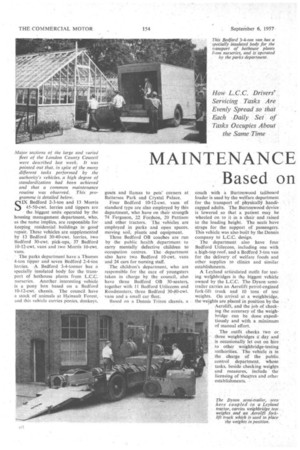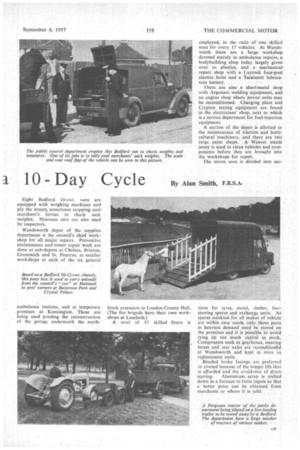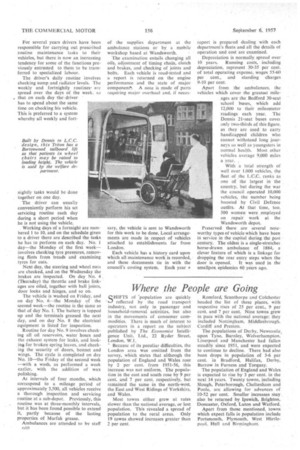MAINTENANCE Based on
Page 54

Page 55

Page 56

If you've noticed an error in this article please click here to report it so we can fix it.
10 Day Cycle By Man Smith, F.R.S.A.
Major sections of the large and varied fleet of the London County Council were described last week. it was pointed out that, in spite of the many different tasks performed by the authority's vehicles, a high degree of standardization had been achieved and that a common maintenance routine was observed. This programme is detailed below.
SIX Bedford 2-3-ton and 13 Morris 45-50-cwt. lorries and tippers are • the biggest units operated by the housing management department, who, as the name implies, are responsible for keeping residential buildings in good repair. These vehicles are supplemented by 13 Bedford -30-40-cwt. lorries, two Bedford 30-cwt. pick-ups,37 Bedford 10-12-cwt. vans and two Morris 10-cwt. vans.
The parks department have a Thames 4-ton tipper and seven Bedford 2-4-ton lorries. A Bedford 3-4-tonner has a specially insulated body for the transport of hothouse plants from L.C.C. nurseries. Another interesting vehicle is a pony box based on a Bedford 10-12-cwt. chassis. The council have a stock of animals at Hainauft Forest, and this vehicle carries ponies. donkeys. goats and llamas to pets' corners at Battersea Park and Crystal Palace.
Four Bedford 10-12-cwt. vans of standard type are also employed by this department, who have on their strength 74 Ferguson, 22 Fordson, 20 Pattison and other tractors. The vehieles are employed in parks and open spaces, moving soil, plants and equipment.
Three Bedford OB coaches are run by the public health. department to carry mentally defective children to occupation centres. the department also have two Bedford -10-cwt vans and 24 cars for nursing staff.
The children's department, who are responsible for the care of youngsters taken in charge by the council, also have three Bedford 013 30-seaters, together with 11 Bedford Utilecons and Roadmasters, three Bedford 30-40-cwt. vans and a small car 'fleet.
Based on a Dennis Triton chassis, a coach with a Burtonwood tailboard loader is used by the welfare department for the transport of physically' handicapped adults. The Burtonwood device is lowered so that a patient may be wheeled on to it in a chair and raised to the loading height. The seats have straps for the support of passengers. This vehicle was also built by the Dennis company to L.C.C. design,
The department also have four Bedford Utilecons, including one with• a high-top roof, and a Bedford 3-ton van for the delivery of welfare foods and other supplies to clinics and similar establishments.
A Leyland artieulated outfit for testing weighbridges is the biggest vehicle owned by the L.C.C. The Dyson semitrailer carries an Aerolift petrol-engined fork-lift truck and 10 tons of test weights. On arrival at a weighbridge, the weights are placed in position by the Aerolift, and the job of checking the accuracy of the weighbridge can be done expeditiously and with a minimum of manual effort.
The outfit checks two or three weighbridges a: day and is occasionally let out on hire to other weighbridge-testing authorities. The vehicle is in the charge ofl the public control department, whose tasks, beside checking weights and measures, include the licensing of theatres and other establishments. Eight Bedford 10-cwt. vans are equipped with weighing machines and ply the streets, sometimes stopping coal merchant's lorries to check sack weights. Nineteen cars are also used by inspectors.
Wandsworth depot of the supplies department is the council's chief workshop for all major repairs. Preventive maintenance and minor repair work are done at sub-depots at Chelsea, Brixton, Greenwich and St. Pancras, at smaller workshops at each of the six general ambulance stations, and at temporary premises at Kennington. These are being used pending the reconstruction of the garage underneath the north block extension to London County Hall, tions for tyres, metal, timber, fast (The fire brigade have their own workmoving spares and exchange units. As
shops at Lambeth.) spares stockists for all makes a vehicle
A total of 55 skilled fitters is are within easy reach, only those parts
in heaviest demand need be stored on the premises and it is possible to avoid tying up too much capital in stock. Components such as gearboxes, steering boxes and rear axles. are reconditiontd at Wandsworth and kept in .store as replacement units.
..Bonded brake facings are preferred to riveted because of the longer life that, is afforded and the avoidance of drum.
scoring. Aluminium scrap is Melted down in a furnace to form ingots so that a. better price can be obtained from merchants to whom it is sold.
For several years drivers have been responsible for carrying out prescribed routine maintenance tasks to their vehicles, but there is now an increasing tendency for some of the functions previously entrusted to them to be transferred to specialized labour.
The driver's daily routine involves checking sump and radiator levels. The weekly and fortnightly routines, are spread over the days of the week, so that on each day the driver •
has to spend about the same time on checking his vehicle.
This is preferred to a system whereby all weekly and fort nightly tasks would be done together on one day.
The driver can usually conveniently perform his set servicing routine each day during a short period when he is not using the vehicle.
Working days of a fortnight are numbered 1 to 10, and on the schedule given to a driver there are described the tasks he has to perform on each day. No. 1 day—the Monday of the first week— involves checking tyre pressures, removing flints from treads and examining tyres for cuts.
Next day, the steering and wheel nuts are checked, and on the Wednesday the brakes are inspected. On day No. 4 . (Thursday) the throttle and brake linkages are oiled, together with ball joints, door locks and hinges, and so on.
The vehicle is washed on Friday, and on day No. 6—the Monday of the second week—the routine is the same as that of day No. 1. The battery is topped up and the terminals greased the next day, and on day No. 8 the electrical equipment is listed for inspection.
Routine for day No. 9 involves checking all oil reservoirs, water hoses and the exhaust system for leaks, and looking for broken spring leaves, and checking the security of doors, bonnet and wings. The cycle is completed on day No. 10—the Friday of the second week —with a wash, as performed a week earlier, with the addition of wax polishing.
At intervals of four months, which correspond to a mileage period of approximately 3,500, all vehicles receive a thorough inspection and servicing routine at a sub-depot. Previously, this routine was at three-monthly intervals, but it has been found possible to extend it, partly because of the lasting properties of Marfak grease.
Ambulances, are attended to by staff 1110 of the supplies department at the ambulance stations or by a mobile workshop based at Wandsworth.
The examination entails changing all oils, adjustment of timing chain, clutch and brakes, and checking of joints and bolts. Each vehicle is road-tested and a report is returned on the engine performance and the state of major component!. A note is made of parts requiring major overhaul and, if neces sary, the vehicle is sent to Wandsworth for this work to be done. Local arrangements are made in respect of vehicles attached to establishments far from London.
Each vehicle has a history card upon which all maintenance work is recorded, and these documents tie in with the council's costing systerh. Each year o
report is prepared dealing with each department's fleets and all the details of operation and cost are examined. Depreciation is normally, spread over 10 years. Running costs, including depreciation, represent 30-35 per cent. of total operating expense, wages 55-60 per cent., and standing charges 9-10 per cent.
Apart from the ambulances, the vehicles which cover the greatest mile ages are the Bedford 30-seat school buses, which add 12,000 to their mileometer readings each year. The Dennis 21-seat buses cover only two-thirds of this figure, as they are used to carry handicapped children who cannot withstand long journeys so well as youngsters in normal health. Most other vehicles average 9,000 miles a year. , With a total strength of well over 1.000 vehicles, the fleet of the L.C.C. ranks as one of the largest in the country, but during the war the council operated 10,000 vehicles, the number being boosted by Civil Defence outfits. At that time, too, 500 women were employed on repair work at the Wandsworth depot.
Preserved there are several noteworthy types of vehicle which have been in service in the capital during the past century. The oldest is a single-stretcher horse-drawn ambulance of 1884, a clever feature of which is a linkage for dropping the rear entry steps when the door is opened. It was used in the smallpox epidemics 60 years ago.




























































































































